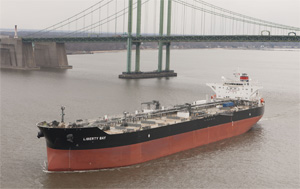Aboard SeaRiver Maritime’s newest U.S.-flag crude carrier, crew morale was sky high.
The 823-foot Liberty Bay had just been officially delivered from Aker Philadelphia Shipyard in June 2014, and the SeaRiver crew was outfitting the tanker in preparation to depart the Delaware River for the ship’s introduction to its West Coast trade route.
Capt. Shawn Wilcox and chief engineer Curt Carter — both career SeaRiver men — agreed that Liberty Bay is the best-designed ship they had ever seen. The company’s first Liberty-class vessel includes redundant major systems and several special features that are tailored to operations in the North Pacific, where it is already at work transporting Alaska crude to refineries.
Liberty Bay is SeaRiver’s first new tanker since 1987. The 115,000-dwt ship is the largest vessel of any type constructed in Philadelphia in 70 years. It’s the largest constructed anywhere on the East Coast in at least 35 years.
The 800,000-barrel-capacity ship is 144 feet wide, with a depth of 68.9 feet and a summer draft of 49.2 feet. It’s about as massive a newbuild as can possibly be accommodated at Aker Philadelphia, said Scott Clapham, the yard’s senior vice president of projects and business development.
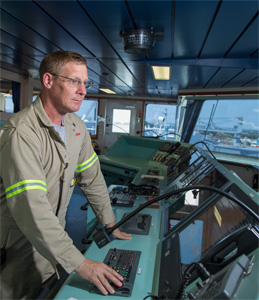 |
|
Capt. Shawn Wilcox sets up his bridge electronics, which include a Transas ECDIS and multiple monitors. |
|
Dennis Symons |
“It’s the largest ship we’ve built, so it required some special analysis of how we were to launch the ship from the dry dock — the float portion,” Clapham said. “There was only one meter on each side of the ship.”
The SeaRiver crew is already enjoying Liberty Bay’s advancements, including its operational monitoring systems, custom-designed safety features, fuel-efficient power generation, electronic controls and minimized environmental footprint.
The integrated control monitoring system means the bridge and engine-room crews each have access to the other’s gauge data. For example, radar displays and ECDIS repeaters are installed in the engine control room, and engine-performance images are available on the bridge. The extra displays improve everyone’s situational awareness and help make operations safer and more efficient.
“We can monitor every system in the engine room or on deck,” Carter said.
“If we’re coming up a river and I have to send an engineer up to change a pump or something, I can see we’re about to come to a turn, so let’s wait 10 minutes,” he said. “If I see the load on the engine going up, I can look and see that he’s hard-over going into a turn, I know it’s not something with the engine.”
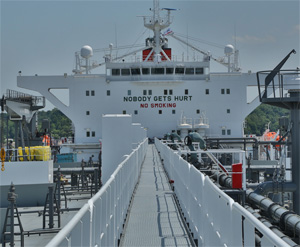 |
|
Liberty Bay is equipped with a full-length catwalk. |
|
Dennis Symons |
The ship has five engine-monitor screens — two in the engine room and one each in the engineer’s office, cargo control room and on the bridge. Because engineers are responsible for more and more paperwork these days, Carter said it’s good to be able to monitor conditions such as temperature, fuel transfers and pump usage right from his desk. The electronic nature of the engine’s systems means components such as the oil mist detector, flame scanner or bearing-wear monitor will alert the crew automatically.
During voyages in the Gulf of Alaska, SeaRiver tankers can encounter heavy weather including 50-foot swells, gale-force winds and even seaquakes. The company hardened Liberty Bay by adding a raised forecastle, a series of breakwaters on the deck and various precautionary features to reduce exposure to the elements. A centerline raised walkway — or catwalk — allows crew to access the forecastle safely even when heavy weather batters the bow.
“We needed something to protect the equipment,” Wilcox said. “We have breakwaters probably every 50 to 100 feet, and these are very, very solid steel structures. We’re looking ahead and thinking what could happen. … We have loop seals on deck that most ships don’t have. It’s for spill containment.”
 |
The ship’s size, cargo capacity, hull, moorings and other systems were customized with an eye toward Liberty Bay’s regular ports of call — including Port Angeles, Cherry Point, Anacortes and Tacoma in Washington — and to accommodate draft restrictions on the way in and out of Richmond, Calif.
The hull is enhanced with reinforced tug push areas — higher stiffening for ship-assist in Prince William Sound. The vessel has port and starboard cranes instead of just one center crane. Sea chest, piping and cargo tank sump thicknesses are all greater than the class requirement. In addition to reinforcing the gear, the designers moved certain items out of Mother Nature’s path.
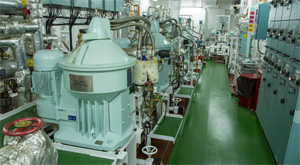 |
|
In Liberty Bay’s fuel-handling room, much of the equipment is raised on skids. |
|
Dennis Symons |
“We wanted as much piping as possible below the deck,” Carter said. “The valves are below the deck — anything that could get damaged in the weather. It’s easier on the equipment and it makes our job a lot easier.”
Liberty Bay’s double-hull design is of Korean origin, with modifications.
“The vessel is based on proven Aframax vessels built at Samsung Heavy Industries,” Clapham said. “The breakwaters and raised forecastle, they were two modifications that we made to the Samsung design in consultation with Samsung.”
Propelling the single-screw ship is a six-cylinder MAN B&W 6S60MC-C8.2 Tier 2 main engine. Normal operating speed is 15 knots, and the ship can switch between heavy fuel and low-sulfur diesel at sea speed. Three Yanmar 925 kW generators provide the auxiliary power. To help achieve emissions standards at Valdez, Alaska, there are two electric ballast pumps and the boilers and generators are set up to be able to run on only diesel.
The generators are electronically integrated to ensure an efficient load distribution depending on the task. In a pinch, any one of the three could run the ship.
“The electrical (generation) here is pretty amazing. If you want to run a ballast pump, you have to ask the system for permission, and if it doesn’t have enough power, it will automatically start up a second generator,” Carter said. “This ship is really set up nice to keep us out of trouble power-wise.”
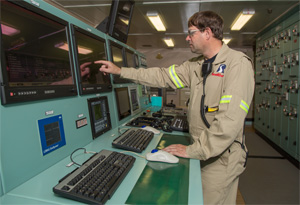 |
|
Chief engineer Curt Carter monitors the ship’s operation from his control room. |
|
Dennis Symons |
On the bridge, the navigation officers enjoy a 360-degree view with convenient access to Furuno radar, Transas ECDIS and JRC automated information system displays.
“The bridge team concept is fabulous. Everybody has an ECDIS,” Wilcox said while moving around on the bridge. “The layout is better than any other I’ve seen. When you stand here at the radar, you can look straight out the window. When you come over here to look at the ECDIS, you are still looking straight out the window.”
Liberty Bay has 18 closed-circuit video cameras, enhancing not only security but also operational awareness. Some of the cameras are installed to view the deck and other working areas. Others are pointed at machinery. “I even have one trained on the stack,” Carter said.
As is the industrywide trend, SeaRiver sought detailed input from its crews when designing and equipping the Liberty-class tankers, said Paul Dawson, the company’s operations superintendent.
“We didn’t just ask them about the big things. We asked them about the small things. What hand tools do you want? What welders do you want? It’s the equipment they like and the equipment they want to use,” Dawson said.
One particular challenge in building Liberty Bay in 2013-14 was anticipating what the ballast water treatment requirement ultimately would be and where the system’s electrolyzer, pumps and filters would be positioned below. SeaRiver chose a BalPure chlorine-and-filter system made by Severn Trent De Nora.
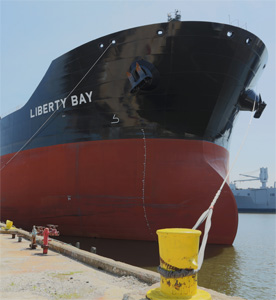 |
|
The 823-foot Liberty Bay is moored at Philadelphia shortly after the Aker shipyard officially delivered the tanker to SeaRiver. Whitehill Manufacturing of nearby Chester, Pa., provided the 1 3/8-inch mooring lines, which include the white HMPE protective overjacket. |
|
Dennis Symons |
“Not only did we need to find real estate, the ballast water treatment technology was continuing to evolve, so (Severn) was continuing to work with us on a solution while we were building the ship,” Clapham said. “It was a large piece of equipment to incorporate.”
Two chillers, with a total of four compressors, improve the viscosity of the diesel fuel. In their fuel-handling room, the engineers have Alfa Laval fuel purifiers. Machinery distributes heavy fuel, diesel and lube oil. Most of the gear and pumps are mounted off the floor on fuel skids.
“It’s really nice to have the equipment elevated,” Carter said. “If you have a leak, you can get down there and clean it up.”
A second Liberty-class ship is scheduled for delivery by early 2015. Together, the two ships cost $400 million.
The SeaRiver order has contributed to a resurgence at Aker Philadelphia. The yard is building four smaller product tankers for Crowley Maritime, two vessels for Philly Tankers LLC and a pair of containerships for Matson Navigation.

